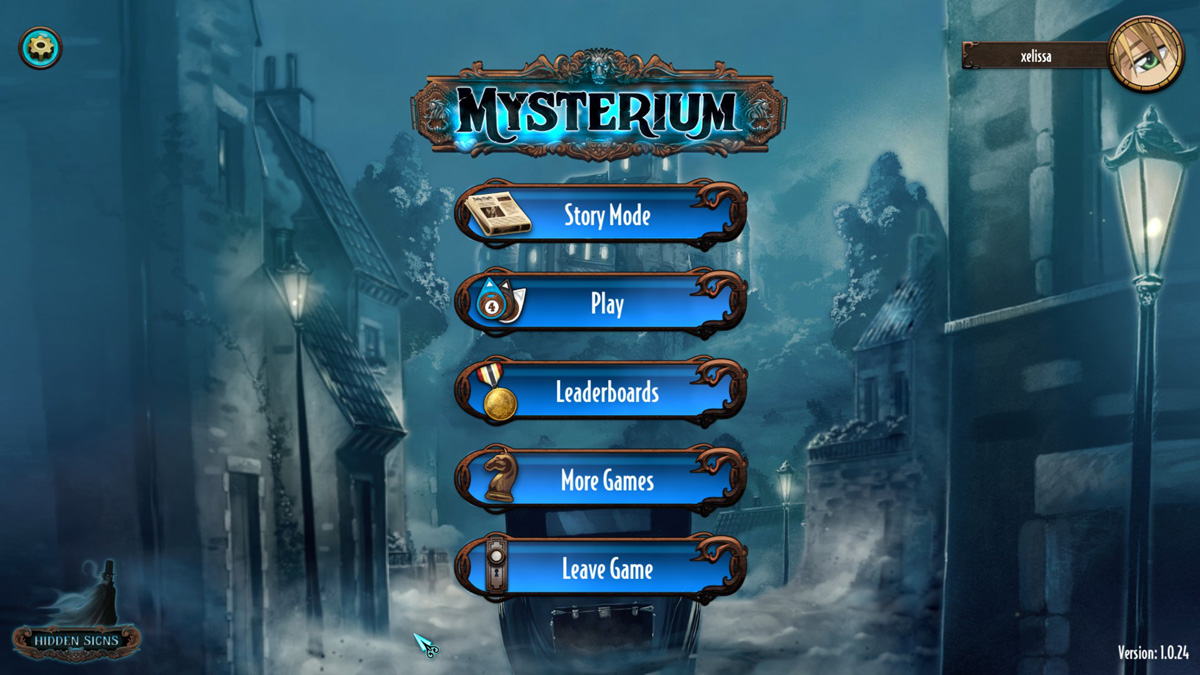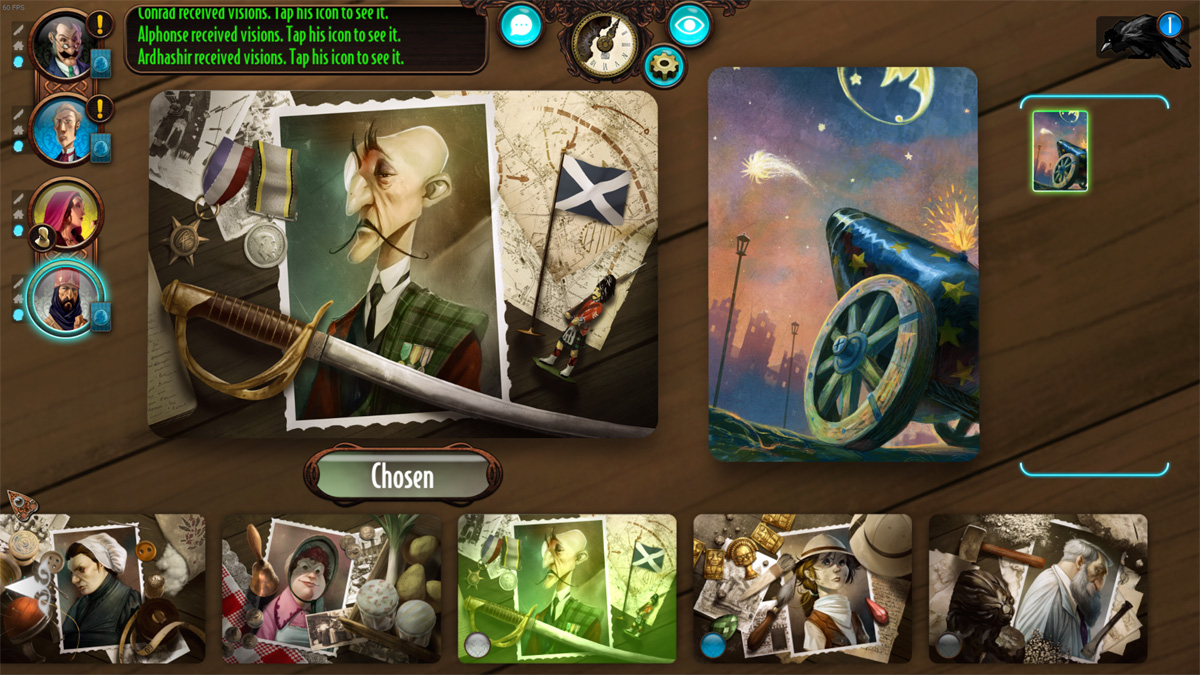

Designer board games are getting quite popular these days, to the point where we’re starting to see quality digital adaptations of them. Though co-op board games are a popular genre (check out Marc’s Tabletop Co-op series), surprisingly few of these games have been adapted from their cardboard forms. Mysterium bucks this trend, being a digital adaptation (on PC, Android, and iOS) of a popular cooperative board game by the same name that came out in 2015.
Mysterium is a turn-based game where a group of psychic detectives attempt to solve a cold murder case. Eschewing mundane investigation, they psychics do this by directly communing with the ghost of the murder victim. Unfortunately for our ghost and our psychics, it’s not as clear cut as the ghost telling them it was John in the Ballroom with the barstool. The ghost can only send them very strange visions to get them to identify certain suspects, locations, and items.

A few different modes are available in the game: the standard game (online or solo), Blitz mode (4-6 players play as the psychics with an AI ghost player), and Story Mode (9 cases played solo only, with the first 4 composing the game’s tutorial). For this review, I’ll be concentrating on the standard online game mode since it’s the core of the game’s experience.
Mechanically, Mysterium supports 2-7 players, with one player taking the role of the ghost and the rest of the players taking the role of psychics. While all players win or lose as a team, the ghost and psychics have asymmetrical roles. Each psychic has a certain person, location, and item that the ghost is trying to get him or her to guess, and these do not overlap with any of the other psychics. They have seven rounds (thematically, each round is called an “hour”) to successfully identify their complete suspect portfolio, first starting with person, then moving onto location, and then finally onto item. At each step, there’s a common pool of people, locations, and items all of the players share (collectively referred to as Psychic cards), so if one psychic correctly guesses their location before another psychic, the second psychic has one less location to consider for their guess.

The ghost (who in the narrative is a deceased man, so I’ll be using masculine pronouns for him) has a hidden board where he can see all the suspect portfolios assigned to each psychic. The only way he is permitted to communicate with the psychics is by giving them one or more vision cards as a clue to whatever card he is trying to get the psychic to guess. There are many ways he could approach this, such as using some particular object on the vision card or the color scheme to suggest a particular Psychic card. He also only has seven cards to work with at a time, only being able to draw new cards two different ways: drawing back up after he hands cards off as clues, or using one of his precious Crows to discard any number of cards from hand and draw back up. The game difficulty will dictate how many Crows the ghost gets in a game, ranging from one per round to one for the entire game.
After the ghost distributes his selected vision cards to the psychics, a two-minute timer starts. Each psychic must select a suspect/location/object based on the clues by the end of this time, but their fellow psychics can aid them. This table-talk is much of the Mysterium experience, where the psychics can look at each other’s clues and puzzle out which cards the ghost is trying to get them to guess. It can also be helpful (or agonizing) to the ghost, because he gets to hear how everyone is interpreting his visions. Psychics can begin talking things out and looking at each other’s cards from the moment the first psychic is given cards, so they have a good deal longer than two minutes to do this.
After all psychics have chosen their cards, a new screen reveals which psychics have moved on to the next category. If all psychics have cleared all three categories by the end of the 7th round, the game enters its finale. The ghost selects one suspect portfolio (a linked person, location, and object) from all the possible portfolios that are visible to the psychics. He then assigns one vision card to each of the elements of the portfolio, then shows the vision cards to all of the psychics simultaneously. The psychics vote secretly for the portfolio they think matches the vision cards best, this time unable to discuss their decision with each other. If the majority of psychics have voted for the correct suspect portfolio, all of the players win. Ties between portfolios are broken by clairvoyancy points (if playing with the clairvoyancy rules) or first player to successfully guess their complete portfolio from the previous rounds.
One thing to note is that if you’re playing with only one or two psychic players, each player takes on the role of two different psychics for balance reasons. This may be a little confusing for the psychic players their first game or two (they have to keep their thoughts on their two psychics separate, because each psychic has their own suspect portfolio), but after that it shouldn’t be a problem. I know that some people really resist taking on more than one role in a game, and if that’s the case for you and your friends, then you’ll need a minimum of 4 players (1 ghost, 3 psychics). Neither I nor my friends had an issue with this, so it played perfectly fine for us with only two psychic players. I do feel, however, that the game loses a bit of something if only playing with two players (1 ghost, 1 psychic), so I would recommend the 3-7 player count for most games so the psychics can bounce ideas off each other.
Overall, I found the digital adaptation of Mysterium to be really well done, fully capturing the gameplay experience of the tabletop version. Rather than getting too hung up on replicating the full table, the game shows one player’s view at a time with the Psychic cards at the bottom of the screen. Players only have to click on a character’s portrait to switch to their view, and the ghost player can bring up his complete portfolio board at any time by clicking the Eye icon in the top menu. The interface is very strong, with my only minor complaint being that often psychics will have to scroll between their Psychic cards because there are too many to fit on the screen at the same time. This can sometimes lead to certain cards being overlooked. This is extremely minor, though, and once players are aware of it, they probably won’t make the same mistake again.
Honestly, my only reservation about the game is how players decide to approach it. Mysterium is a social game where players are trying to figure out how other players think and interpret things. Most of the fun comes from the table-talk of psychics trying to figure out their visions together as well as the ghost explaining what he was thinking or feeling after the game concludes. And while this digital version does have a chat box as well as a way to highlight certain spots on cards for other players to see, this will always be a game that plays best with full voice chat. In this day and age where many voice chat programs are free and easy to use, getting that set up shouldn’t be a problem. It does mean, however, that you’ll probably only want to play this game with people you already know.
The game’s community also reveals that I’m not the only one that thinks this. Even though the game is playable across platforms, the public lobby is nearly deserted and it’s often difficult to find a game on your own because so few people are looking for other players. Story Mode and Solo Mode may be decent diversions every once in awhile, but they’re not nearly fun enough on their own to constitute a solid gaming experience. Unfortunately, I can’t comment directly on Blitz Mode since I was never able to find a game to jump into, and it seems likely that this will be the case for most players unless they have at least 3 other friends to play with. The meat here is the standard mode with other players, and the good news is that the game makes it exceptionally easy to connect to a friend’s game. While there are some small flaws (e.g. you can’t make a game private), these don’t detract much from the overall gaming experience.
If you have a couple of friends who don’t mind jumping into voice chat with you, then I wholeheartedly recommend checking out Mysterium if it sounds at all interesting to you. I love playing the physical version of Mysterium with friends, and the digital adaptation fully embraces all of the conveniences afforded to it. I’m very glad indeed that I can now play this excellent game with my friends that live too far away for game night.